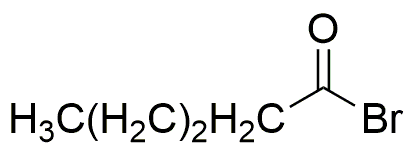Valeryl bromide is widely utilized in research focused on:
- Synthesis of Organic Compounds: It serves as a key reagent in the synthesis of various organic compounds, particularly in the production of esters and amides, which are essential in pharmaceuticals and agrochemicals.
- Intermediate in Drug Development: This compound is often used as an intermediate in the development of new drugs, allowing researchers to modify molecular structures to enhance efficacy and reduce side effects.
- Laboratory Research: Valeryl bromide is frequently employed in academic and industrial laboratories for chemical reactions, helping chemists explore new pathways and reactions in organic chemistry.
- Production of Surfactants: It can be utilized in the formulation of surfactants, which are important in detergents and emulsifiers, improving the performance and stability of cleaning products.
- Chemical Analysis: This compound is also valuable in analytical chemistry, where it can be used as a standard or reagent in various analytical techniques, aiding in the identification and quantification of other substances.
General Information
Properties
Safety and Regulations
Applications
Valeryl bromide is widely utilized in research focused on:
- Synthesis of Organic Compounds: It serves as a key reagent in the synthesis of various organic compounds, particularly in the production of esters and amides, which are essential in pharmaceuticals and agrochemicals.
- Intermediate in Drug Development: This compound is often used as an intermediate in the development of new drugs, allowing researchers to modify molecular structures to enhance efficacy and reduce side effects.
- Laboratory Research: Valeryl bromide is frequently employed in academic and industrial laboratories for chemical reactions, helping chemists explore new pathways and reactions in organic chemistry.
- Production of Surfactants: It can be utilized in the formulation of surfactants, which are important in detergents and emulsifiers, improving the performance and stability of cleaning products.
- Chemical Analysis: This compound is also valuable in analytical chemistry, where it can be used as a standard or reagent in various analytical techniques, aiding in the identification and quantification of other substances.
Documents
Safety Data Sheets (SDS)
The SDS provides comprehensive safety information on handling, storage, and disposal of the product.
Product Specification (PS)
The PS provides a comprehensive breakdown of the product’s properties, including chemical composition, physical state, purity, and storage requirements. It also details acceptable quality ranges and the product's intended applications.
Certificates of Analysis (COA)
Search for Certificates of Analysis (COA) by entering the products Lot Number. Lot and Batch Numbers can be found on a product’s label following the words ‘Lot’ or ‘Batch’.
*Catalog Number
*Lot Number
Certificates Of Origin (COO)
This COO confirms the country where the product was manufactured, and also details the materials and components used in it and whether it is derived from natural, synthetic, or other specific sources. This certificate may be required for customs, trade, and regulatory compliance.
*Catalog Number
*Lot Number
Safety Data Sheets (SDS)
The SDS provides comprehensive safety information on handling, storage, and disposal of the product.
DownloadProduct Specification (PS)
The PS provides a comprehensive breakdown of the product’s properties, including chemical composition, physical state, purity, and storage requirements. It also details acceptable quality ranges and the product's intended applications.
DownloadCertificates of Analysis (COA)
Search for Certificates of Analysis (COA) by entering the products Lot Number. Lot and Batch Numbers can be found on a product’s label following the words ‘Lot’ or ‘Batch’.
*Catalog Number
*Lot Number
Certificates Of Origin (COO)
This COO confirms the country where the product was manufactured, and also details the materials and components used in it and whether it is derived from natural, synthetic, or other specific sources. This certificate may be required for customs, trade, and regulatory compliance.

